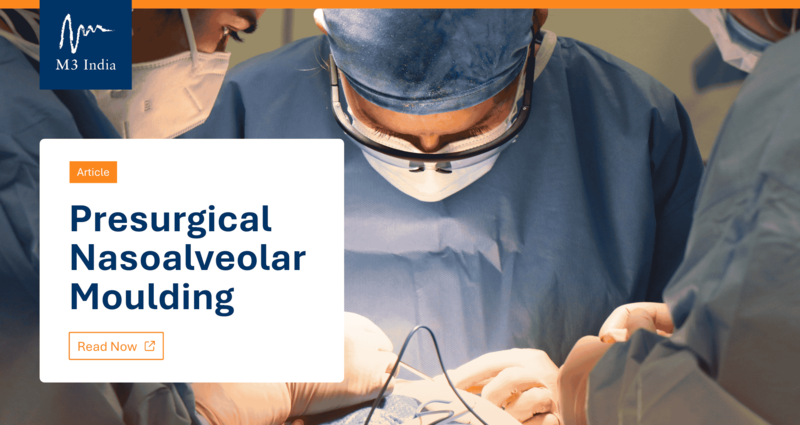Article: Presurgical Nasoalveolar Moulding
M3 India Newsdesk May 26, 2025
Pre-surgical Nasoalveolar Moulding PNAM was earlier known as “Pre-surgical orthopaedics”. This article explains the techniques, appliances, benefits and controversies about PNAM.
Pre-surgical Nasoalveolar Moulding PNAM
- Grayson et al. (1999) created the first presurgical nasoalveolar moulding (PNAM) device
- Before undergoing CLCP surgery, nasoalveolar moulding is a nonsurgical technique that reshapes the gums, lip, and nostrils to lessen the severity of the cleft
- Reducing the soft tissue and cartilaginous cleft deformity is the main goal of PNAM to enable surgical soft tissue repair under ideal circumstances with the least amount of stress and to reduce the creation of scars
- It provides the optimal arch form, normalises the position of the tongue, facilitates speech development, enhances attractiveness and provides a psychosocial boost, and improves feeding and bone contour. It also permits stimulation and redirection of growth for the regulated, predictable repositioning of the alveolar segments
- As soon as possible after birth, PNAM should begin
- Moulding of tissue is much easier in the early days of a newborn because there is an increased level of maternal estrogen and hyaluronic acid in neonates, which increases the tissue flexibility, making it ideal for moulding
- Developing nasal cartilage can be subjected to repositioning within the first six weeks of life, and this aids in increasing the nasal height during moulding
- Changes are made incrementally till bony segments reach a favourable position
- Reduces the severity of cleft. Approximates alveolar and lip segments
- Decreases the nasal base width
- Elongates columella – eliminates surgical correction
Technique
Impression—It is carried out within the first week of birth using heavy body silicone material in the presence of a surgeon to handle any airway emergency. To keep the tongue from falling back and to drain all of the oral fluids, the posture is inverted. Thus, an Impression is obtained, and excess material is removed from the oral cavity.
Appliance
- The PNAM appliance consists of a removable alveolar moulding plate made of orthodontic acrylic from a dental cast of the infant's maxilla.
- The nasal stent is bent at the end of a 0.032-inch stainless steel wire that is embedded into the anterior portion of the alveolar moulding plate.
- Included when the alveolar gap is 5 mm wide.
- Gap reduction: better lip alignment and nose base
- “Swan neck” design
- The nasal stent and the intraoral moulding plate are adjusted weekly or biweekly to gradually correct the nasal and alveolar. deformities, giving rise to the name nasoalveolar moulding.
- The full spectrum of cleft abnormalities, including complete clefts without an intact nasal floor, can be treated with PNAM.
- Primary surgical repair is done after NAM therapy is completed.
- 3-4 months: repair of lip and nose.
- Gingivoperioplasty - repair of alveolar segments.
Benefits
- Proper alignment of the alveolus, lip and nose.
- Better and more predictable surgical results.
- There is less scar tissue, and the nasal shape change is stable (Maull, 1999).
- Reduction in surgical revision for excessive scar tissue, orofacial fistulas and nasal/facial deformities.
- Permanent teeth have a better chance of proper eruption.
Benefits (Studies)
- Santiago (1998): 60% of NAM cases (with gingivoperioplasty) did not require secondary bone grafting.
- Lee et al. (2004): Midfacial growth in the sagittal and vertical planes was unaffected by NAM and gingivoperioplasty.
- Kornbluth et al. (2018): Compared dental arch relationship, craniofacial form, and nasolabial aesthetic outcomes. Comparison: No pre-surgical infant orthopaedics, Latham appliance, Nasoalveolar moulding.
Results:
Latham appliance with early lip and nose revision surgery à better aesthetic outcome; worse maxillary growth.
NAM without early revision surgery à improved aesthetic outcome; better maxillary growth.
- Bhutiani et al. (2020)
- Evaluated the stability of NAM after 1 year
- Arch width increased significantly with NAM treatment
- Improved nasal symmetry
- No effect on premaxilla growth restriction
- Stable outcomes after 1 year
Drawbacks:
- Labour-intensive
- Irritation of the oral mucosa, gingival tissue or nasal mucosa
- Tissues may ulcerate from excessive pressure applied by the appliance
- If excess force is applied through the nasal stent, à Intranasal lining inflammation
- Cheek irritation due to skin taping
Controversies(Studies)
1. Ross (1987)
The growth and development of the face are unaffected by preoperative orthopaedics.
2. Lee et al. (2004)
Midfacial growth in the sagittal and vertical planes is unaffected by NAM and gingivoperioplasty.
3. Nayak et al. (2018)
No differences in the maxillomandibular position or relationship, mandibular plane, lower facial height, or incisor angulation between NAM and no-NAM groups at 7 years of age.
4. Hoshal et al. (2020) - Review - Major arguments against NAM
- Possible inhibition of midface growth
- Potential relapse of the nasal change
Disclaimer- The views and opinions expressed in this article are those of the author and do not necessarily reflect the official policy or position of M3 India.
About the author of this article: Dr Neha Kalantri is a practising dentist from Nashik.
-
Exclusive Write-ups & Webinars by KOLs
-
Daily Quiz by specialty
-
Paid Market Research Surveys
-
Case discussions, News & Journals' summaries
